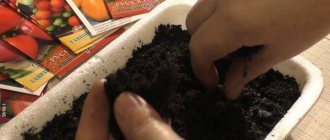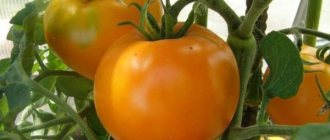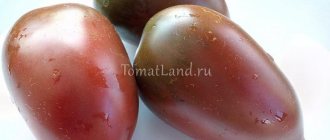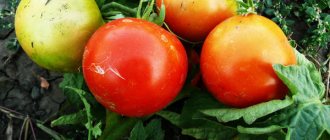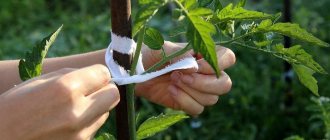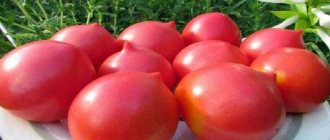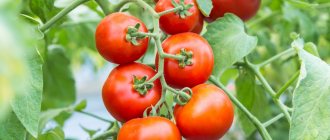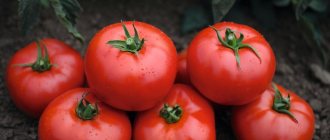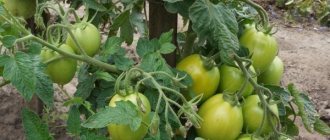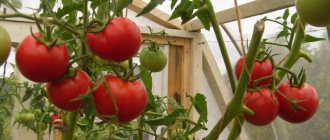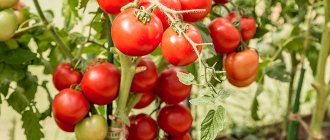Lev Tolstoy F1 is a relatively new hybrid in our gardens, but it has already become a favorite among many summer residents and those who grow tomatoes for sale. The plant is unpretentious, withstands cold weather, can even take root on a balcony and bears fruit abundantly.
| Height | Landing location | Ripening time | Fruit color | Fruit size | Origin | Fruit shape |
| Medium height | Greenhouse, Open ground | Mid-early | Reds | Large | Hybrid | Flat-round |
Description of Lev Tolstoy tomatoes
Tomato Lev Tolstoy F1 is a young hybrid of the first generation. The plant is of a determinant type; in open ground it reaches a height of 1 m, in protected ground – 1.2 m, then it independently completes its growth.
The top, unlike tomatoes with unlimited growth, ends in a flower raceme. The side shoots also complete their growth. Thanks to this characteristic, the bush grows compact. In the greenhouse, such plants must be placed so that they are not shaded by taller tomatoes.
Tomatoes can be grown without pinching or staking
The leaves of the crop are of medium length, light green in color, moderate foliage. The inflorescences are simple. The ripening period is average, the fruits appear 120 days from the start of cultivation. Hybrid Lev Tolstoy F1 is distinguished by its endurance to weather conditions and diseases. The crop is approved for cultivation in all regions, but is recommended for protected soil.
Important! When choosing seeds, you should take into account that there is a tomato with a similar name - Tolstoy F1, which belongs to the Dutch selection and has other characteristics.
Description of fruits
Large tomatoes have a flat-round shape, medium ribbing, and a bright red color when fully ripe. The weight of one tomato of the Lev Tolstoy F1 variety is 250-300 g; at the beginning of fruiting, tomatoes can be larger and reach 500 g. 6-8 fruits appear in the cluster.
Tomatoes are dense, containing from four to six seed chambers inside.
Lev Tolstoy tomatoes have a good taste and rich aroma, which are preserved during processing. The pulp is sugary, fleshy, juicy, comparable to watermelon, and does not have a sharp sourness. To obtain the declared taste, it is necessary to apply regular fertilizing, especially potash.
Productivity
A characteristic feature of the hybrid is prolonged fruiting. New ovaries are formed before autumn frosts. Up to 3 kg of fruits are removed from each bush.
Which regions are best to grow in?
"Lev Tolstoy" is intended for cultivation in central Europe, so it is excellent for cultivation in the European part of Russia. Tomato exhibits the best growth rates in greenhouse conditions. In southern regions with early and long summers, this hybrid is successfully grown in open ground.
Characteristic
A compact bush with self-limiting growth Lev Tolstoy does not need to be pinched, which is especially suitable for beginner gardeners who have not mastered the complex formation of plants. A garter may be required for the brushes to protect them from breaking and lodging.
Hybrid Lev Tolstoy F1 is unpretentious and can withstand temporary cold spells and temperature fluctuations. But it shows the best productivity in protected ground: in greenhouses or under film covers.
Tomatoes appear on the bush throughout the season. The density of tomatoes allows them to be stored and transported over long distances.
Productivity and fruiting
Tomato Lev Tolstoy F1 has a high yield with a medium-sized bush. In film greenhouses, when placing three plants per 1 sq. m, about 12 kg of fruits are collected from them. The number of tomatoes increases when grown in greenhouses, as well as timely watering and fertilizing.
The plant bears fruit for a long time. Productivity can also be increased if unripe fruits are periodically removed, which promotes the appearance of a new ovary.
Area of application of fruits
The excellent taste and bright aroma of the Lev Tolstoy F1 tomato are especially noticeable in fresh salads, as well as sauces and juice. Tomatoes are suitable for various processing and preparation. Sweet tomatoes are also used for preparing main courses and soups.
The fruits contain many useful substances, so they are recommended for children's diets, as well as people watching their weight.
Resistance to diseases and pests
Tomato Lev Tolstoy F1, thanks to complex breeding work, has acquired resistance to various diseases. This makes it possible not to use chemical fungicides when growing and to obtain a pure product. But to maintain plant immunity, it is necessary to keep the soil clean, ventilate, and avoid excessive watering.
Subtleties of agricultural technology
Seed selection
Tomato Tolstoy F1 is popular and in high demand, so there is a risk of stumbling upon a fake. Therefore, you need to choose bags from the most reliable companies, in trusted stores.
If the shelf life is coming to an end, germination can be stimulated with immunomodulators such as Epin or Zircon.
Seedling period
As a rule, hybrid tomato seeds take a little longer to germinate than usual. Knowing the optimal age of seedlings before transplanting to a permanent place (55 days), sowing dates are calculated in advance. This is the end of February (for greenhouses) or the second or third ten days of March (for street ridges) - in climatic zones such as the Moscow region, Southern Urals, Western Siberia.
Seedlings of the variety are prone to elongation
Young seedlings tend to stretch , so timely picking, good lighting, and moderate temperature are needed. Feeding during seedling season is not at all necessary.
Features of growing in a greenhouse
- 3 bushes are placed on one square meter .
- Step-sonning is mandatory. Plants grow in 1-2 stems, no more . At the end of the season, pinch off the tops.
- In hot weather, you need to establish cross ventilation.
- It is advisable to give complex fertilizing weekly, alternating root and foliar.
- The soil in the root zone should be moderately moist at all times. Mulching helps .
- It is necessary to carry out prevention to protect against late blight. If there have been no aggressive outbreaks of the disease before, regular spraying with biological products such as Fitosporin is sufficient. In case of increased danger, you will have to resort to approved chemicals (the most modern - Previkur).
Outdoor garden care
- Maintaining crop rotation will help prevent late blight outbreaks.
- Planting density – 4 plants per square meter.
- A garter to a high support is required .
- The bushes lead into one trunk , removing all the stepsons. In the first ten days of August, the tops of the stems are cut off.
- If the pre-planting filling of the holes is abundant, fertilizing can be done not too often, 1-2 times a month. In June, nitrogen nutrition should predominate, then complex nutrition with microelements. If August is cold, spraying with phosphorus fertilizers is needed.
When grown in a greenhouse, the formation is necessary in 1-2 trunks, outdoors - in one
Work on mistakes
Failures in growing Tolstoy F1 tomato are least dependent on the weather. Usually they happen due to gross mistakes by the owner.
- Seeds take a long time to germinate at too low a temperature, you need to make it +25 +30 degrees .
- Seedlings do not develop in heavy soil and in the absence of drainage holes in the containers.
- Flowers in a greenhouse fall off due to excessive heat.
- Low yields and small fruits occur in dense plantings, without pinching.
Reviews of the Tolstoy F1 hybrid tomato are always complimentary. It makes sense for both beginners and experienced gardeners to pay attention to this variety.
Advantages and disadvantages of the variety
Tomato Lev Tolstoy F1 is a hybrid of Russian selection, medium ripening, created taking into account climatic conditions and is suitable for cultivation in various regions.
pros
- medium-sized compact bush;
- high productivity;
- long fruiting period;
- there is no need for complex shaping and tying of stems;
- beautiful fruits that have a fruity taste, suitable for children's and dietary diets;
- tomatoes can be used for various types of processing;
- the fruits are distinguished by keeping quality and transportability;
- The variety is resistant to typical diseases.
Minuses
- the inability to reproduce the crop with its own seeds;
- it is necessary to maintain soil nutrition throughout the entire growing period.
Tolstoy tomatoes on video
Originator of the hybrid: Bejo Zaden (Holland).
If you grew Tolstoy F1 tomatoes, please write whether you liked them or not. What was the yield and taste of the fruits like under your climatic conditions? How do you rate the disease resistance of this tomato? Describe the advantages and disadvantages of this tomato in your opinion. If possible, attach to the comment a photo of the entire bush as a whole or individual fruits that you grew. Thank you!
Your reviews of the Tolstoy tomato and additions to the description will help many gardeners evaluate this hybrid more objectively and decide whether it is worth planting or not.
The Tomatland website about tomatoes is always at your service.
Features of cultivation
Tomato Lev Tolstoy F1 is grown in seedlings. Sowing begins in March-April, depending on the location of cultivation. Seedlings can be replanted when the soil warms up to the depth of the root system to +15°C.
The seedling period of the culture lasts from 45 to 50 days
For seedlings, prepare a light and nutritious soil based on peat. Coconut substrate is good for growing tomatoes. It has the necessary loose structure and does not support pathogenic microflora.
Before planting, seeds are disinfected in the preparation “Alirin-B”, which will give the plants even greater resistance to fungal infections. Planting containers are also treated.
Sowing is carried out in moist, leveled soil to a depth of 1 cm. Seeds are germinated at a temperature of +25°C... +27°C for 4-5 days. After the emergence of seedlings, the container is moved to the most illuminated place. Plants need 12-14 hours of light per day with a break at night.
When the seedlings have 2-3 true and well-developed leaves, they are planted in larger containers. Including those plants that were grown in individual containers.
Advice! In case of low soil fertility, several granules of complex fertilizer are added to the container during picking.
Seedlings are watered moderately; containers must contain a drainage hole to drain water. A week before transferring to a permanent place, the plants are hardened off.
In open ground or greenhouses, a single-row or double-row planting scheme is used. The distances between plants are about 0.5 cm, in rows - 0.6-0.7 m. The beds are prepared in advance; it is better to plant green manure on them from the previous season to improve and restore the soil. Before planting, the soil is loosened well, all weeds are removed and leveled.
The hole is pre-watered abundantly, complex fertilizer and 1 tbsp are added. ash. The components are mixed with the soil so that the root system does not come into direct contact with them. The plants are transplanted together with a lump of earth, covered with dry soil and lightly pressed.
Advice! In order for a strong root system to form, watering begins only 10 days after transplantation.
In addition to complex fertilizers, it is effective to use ash, which is scattered in a thick layer between the rows during the period of fruit filling. Only dry ash is used, because when wet it quickly releases useful substances.
DIY tomato seedlings
Novice vegetable growers do not always understand when is the best time to sow tomatoes for a greenhouse. Yes, seeds are sown in January, February, and March. So, greenhouse tomato seeds are sown at the end of February. Since Tolstoy is considered an early variety and is intended for the greenhouse, therefore, its seeds are also sown during this period of time.
However, the timing of sowing tomatoes for seedlings in the Moscow region may be slightly different: at the beginning and end of March, for example, those varieties are sown that will be planted in open ground under temporary shelter.
So, how to grow tomato seedlings with your own hands at home? Agricultural cultivation technology is described below.
Prepared seeds are sown in prepared cups with nutritious soil mixture. First, you can sow the seeds in common containers, and then (when the seedlings reach the stage of 2-3 true leaves) transplant them into individual containers. Both options have a right to exist. However, the second is more practical, saving space under the seedlings at the first stages of growing them.
The beds in the greenhouse for transplanting seedlings begin to be prepared in the fall. Or they do it right before planting the plants in the ground. For several years it usually remains unchanged.
Asparagus - home care, photos of species
Pest and disease control
Tomato Lev Tolstoy F1 is resistant to a number of diseases, but it is recommended to treat the soil against pathogens for all crops. In this case, two weeks after planting the seedlings, it is recommended to spill the soil around the bushes with a solution of the fungicide “Glyokladin” at the rate of one tablet per bucket of water.
The soil is spilled both around the bushes and between the rows. Also, to protect against diseases, before planting, seeds are soaked in preparations that disinfect them and saturate them with microelements.
